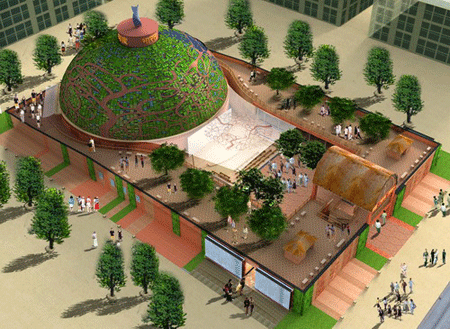India has conducted trial of its theme pavilion, a huge domed structure ressembling the Sanchi Stupa, at the 2010 Shanghai Expo, which is regarded as the most expensive event hosted by China after Beijing Olympics.

Other countries too conducted trial of their theme pavilions to test systems in an event.
China reportedly spent about USD 58 billion to spruce up Shanghai, its richest and most glamorous city and allocated about USD 5 billion for the six month long expo which was expected to be frequented by 70 million visitors.
Set for the May 1 inauguration, India built a huge domed structure resembling Sanchi stupa, an ancient Buddhist monument with its interior structures focusing on the integration between urban and rural regions to suite Expo’s main theme, “Better cities better life.”
Visitors to the pavilion will be led on a journey of Indian cities from ancient times to the present day, Indian officials making arrangements at the expo told PTI here.
The 35 metre wide dome of the Indian pavilion also created a record of sorts as it is the world’s biggest bamboo structure. The pavilion covers 4,000 square meters and is based on traditional themes.
Its building materials, however, are contemporary, consisting of massive solar panels, windmills, herbs and bamboo. The pavilion features India’s rich religious culture, traditional and modern technology and combination of urban and rural life.
It can accommodate 1,500 visitors per hour.
It will feature a shopping arcade where artisans from various regions of India will be demonstrating and selling a wide variety of products.

A food plaza will also provide traditional Indian delicacies. India’s President Prabtibha Patel is scheduled to visit the expo and the Indian pavilion during her four day visit to China beginning from May 26.
The trial runs went off well with hundreds of local people visiting the pavilion, Indian officials said.
vThe British pavilion attracted a great deal of attention as it was totally made of glass tubes each containing well preserved seeds of different plant varieties.
Source : http://www.businessghana.com




